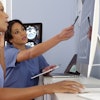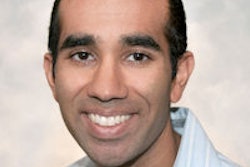
Women's perceptions of better communication with radiologists is associated with lower levels of anxiety both before and after breast biopsies, according to a new study published online in the Journal of the American College of Radiology.
The findings could positively affect women's adherence to breast health follow-up, researchers said.
"Although for some women, recall and biopsy can improve compliance, in other women, persistent anxiety can interfere with motivation to adhere to follow-up recommendations," wrote lead author Dr. Lauren Miller, from Riverside Radiology and Interventional Associates in Columbus, OH, and colleagues (JACR, March 18, 2013).
In 2009, the U.S. Preventive Services Task Force (USPSTF) cited anxiety as one of the harms of mammographic screening that influenced its recommendation to limit screening. Although major medical organizations still support the USPSTF's previously established screening guidelines, this view that significant anxiety can be experienced by women with abnormal biopsy results needs to be addressed, according to Miller.
 Dr. Lauren Miller from Riverside Radiology and Interventional Associates.
Dr. Lauren Miller from Riverside Radiology and Interventional Associates.
"We can never completely relieve a woman's anxiety, but we can ease it," she told AuntMinnie.com. "Breast imaging is unique in that there's quite a bit of interaction between the radiologist and the patient. We're the point people, and we can be a factor in relieving some of the anxiety as well as informing patients. Anxiety can be reduced for women undergoing breast imaging, without affecting screening adherence."
The study included 138 women recommended for imaging-guided breast procedures between August 2010 and February 2011. The procedures included ultrasound-guided or stereotactic-guided core-needle breast biopsies or ultrasound-guided diagnostic cyst aspiration; women participated in the study on the day of their procedure, completing questionnaires immediately before and after biopsies, according to the authors.
The team measured anxiety using the State-Trait Anxiety Inventory (scores range from 20 to 80, with higher scores correlating with greater anxiety). Before their biopsies, women also completed questionnaires regarding their perceived communication with the radiologists recommending the procedures as well as their demographic characteristics and medical history. Immediately after the biopsies, they completed a measure of perceived communication with the radiologists who had performed the procedure. Miller's group also tracked the experience levels of the radiologists recommending and performing the biopsies.
The average age of the study cohort was 52 years. Seventy-three percent of the patients were white, and 91% had diagnostic breast imaging evaluation at the clinic site, with attending breast imaging radiologists (70%) or breast imaging fellows (22%) discussing biopsy recommendations with them. The procedures performed consisted of 102 ultrasound-guided procedures (89 core-needle biopsies and 13 diagnostic aspirations) and 41 stereotactic-guided core-needle biopsies.
The average prebiopsy State-Trait Anxiety Inventory score was 44.5, which decreased to 37.2 after the procedure. White women showed higher levels of anxiety before and immediately after biopsy compared to nonwhite women. The study found no correlation between what the women perceived to be "good communication" and the radiologists' experience level.
How did patient-radiologist communication affect the scores? Miller's team found that better perceived communication with the recommending radiologist was associated with lower prebiopsy anxiety, and better perceived communication with radiologists performing biopsies was associated with lower postbiopsy anxiety. Patients perceived better communication with the radiologists who both recommended and performed the biopsies, compared with those women who had a different radiologist for each task.
"These effects became stronger when controlling for baseline levels of anxiety, indicating that radiologist-patient communication is a unique factor contributing to anxiety," the authors wrote.
Radiologists regularly deliver bad news to patients in the breast imaging setting, but few have had training in how best to do this, according to Miller and colleagues: Given the challenging and sometimes life-altering content of these discussions, patients' perceptions of these communications could greatly influence their psychological states.
"The goal is to overall improve women's experience, not only with proper diagnosis but by assuaging anxiety," Miller told AuntMinnie.com. "We want women to be informed and comfortable during the whole process in the hope that they'll adhere to annual screening protocols."




















